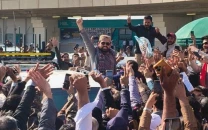A clash between tenacity and technology
Delay in announcement of results casts doubt on polls transparency

Amidst the fervor of the highly contentious elections, the spotlight shifts from the political battleground to the technological arena.
The tale unfolds with a clash between the PTI's resilience and the Election Commission of Pakistan's (ECP) touted Election Management System (EMS) - a clash that will decide the fate of the nation.
With the promise of technological advancement, expectations were high for swift and accurate results. The ECP has heralded its EMS as the emblem of transparency and efficiency in result compilation.
Yet, as the clock struck 2am, the promised unveiling of unofficial results remained elusive, shrouding the election in controversy and reviving the memories of the 2018 election’s Result Transmission System (RTS) debacle.
Despite claims that the new system was capable of working even without the internet, most constituencies – more than 85 percent—awaited their fate, casting doubt on the efficacy of the EMS and transparency of the elections itself.
This setback compounds the existing grievances over an uneven playing field in the pre-election phase, exacerbated by countrywide mobile and internet suspensions under the guise of security concerns throughout the election day.
Nevertheless, amidst the chaos and uncertainty, the PTI emerges as a force to reckon with. Weathering a storm of legal battles, symbol stripping, and communication blackouts, Imran Khan's party asserts its resilience.
Across Khyber Pakhtunkhwa, the PTI-backed candidates hold sway, solidifying their stronghold in Northern Punjab and challenging the PML-N's dominance in urban centers like Lahore and Faisalabad.
The aftermath of the May 9 blunder saw prominent figures deserting the PTI, spawning splinter groups and leaving the party to rally behind fresh faces.
Read: Hours after polling, nation awaits final results of elections
In a bold move, the PTI allocated 55% of its tickets to newcomers, willingly or unwillingly defying conventional wisdom and paving the way for a new breed of leaders.
In the labyrinth of Punjab's political landscape, the PTI squares off against the PML-N that projected itself as a government in the making in the center and Punjab. In Sindh, the PPP continues winning streak, albeit facing resistance in Karachi, a testament to the city's unique political dynamics.
As expected, Balochistan continued to show mixed mandate.
Throughout Pakistan's tumultuous electoral history, a recurring narrative of favoritism and manipulation has marred the democratic process. From the party-less elections of 1985 to the controversial polls of 2018, the cast of characters may change, but the underlying script remains consistent.
With each cycle, tweaked versions of the same manipulative tactics are deployed to engineer desired outcomes, perpetuating a cycle of distrust and disillusionment. In the latest chapter of this saga, the ECP finds itself under scrutiny as suspicions surrounding the EMS come to fruition.
As the nation eagerly awaited election results, screens outside the district returning officer offices, meant to display real-time updates, served as nothing more than a tantalizing tease for media representatives. Denied access to the inner workings of the electoral process, journalists found themselves relegated to a token "media room," left to ponder the opacity shrouding the proceedings.
Despite concerns raised by skeptics in the media, the EMS was thrust into action without a comprehensive test run, underscoring a disregard for due diligence in the pursuit of expediency.
As delays in result compilation mounted, doubts over the ECP's credibility intensified, casting a long shadow over its constitutional mandate to ensure free and fair elections.
As the dust settles and the nation braces for the final verdict, the clash between the PTI's resilience and the ECP's faltering EMS serves as a stark reminder of the challenges inherent in Pakistan's electoral journey. In this high-stakes drama, the battle for transparency and integrity hangs precariously in the balance, with the fate of the nation teetering on the edge.



















COMMENTS
Comments are moderated and generally will be posted if they are on-topic and not abusive.
For more information, please see our Comments FAQ